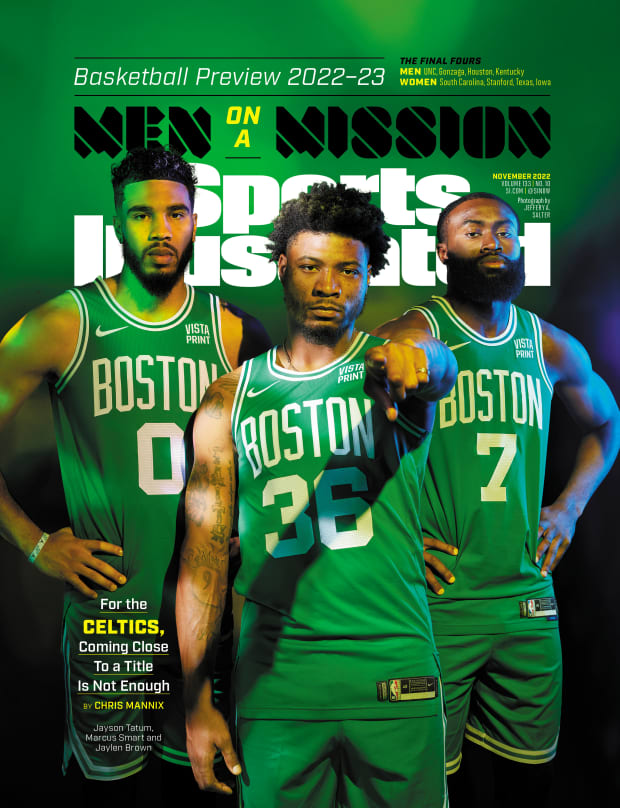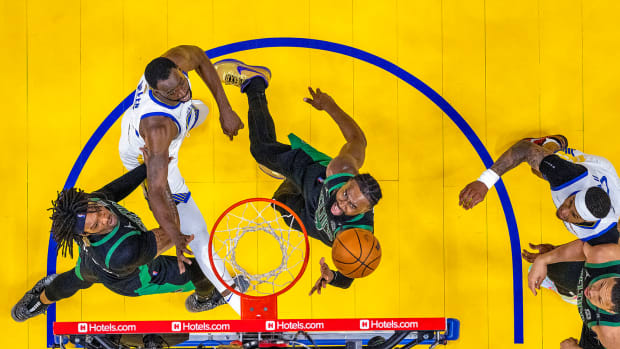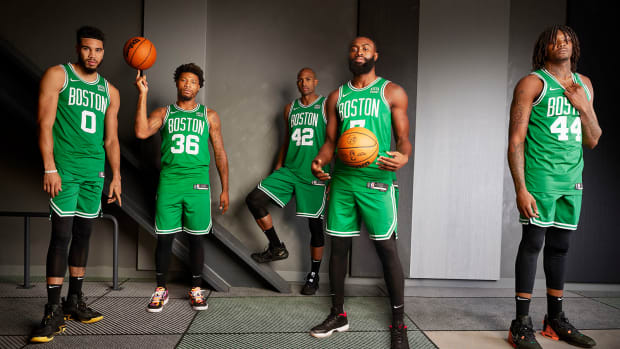In the underbelly of TD Garden, beneath the black upholstered seats and a long outlet pass from the famed parquet floor, the home and road locker rooms lie parallel to each other, separated by only a narrow hallway and a white paint-splashed concrete wall. A very un-soundproof wall, it turns out, one that the Celtics—had they been able to foresee the outcome of the 2022 Finals—would have bolted acoustic panels to years ago. Inside Boston’s locker room, minutes after they dropped a series-clinching Game 6 to Golden State, tears flowed. Blank faces stared down at crumpled stat sheets. Ime Udoka was the first to break the silence. “And I don’t think he wanted to,” says center Al Horford. Outside, the roar from dozens of champagne-soaked Warriors players and personnel was unavoidable. The pulsing from the hip-hop music vibrated through the floors. “Trust me,” says Horford, “we could hear everything.”
Even now, Jayson Tatum winces at the memory. Leaning back in his locker that night, everything he accomplished—All-Star starter, All-NBA First Team, the seventh-highest scoring average (26.9 ppg) in Celtics history—felt meaningless. Showered, changed and fresh from rehashing the Finals with a few dozen reporters, Tatum could still hear the celebration as he walked to his car. “Definitely not a good feeling,” he says. What he saw earlier bothered him more: Golden State’s celebrating on Boston’s home floor. “That,” says Tatum, who shot only 36.7% from the field during the Finals, “I’ll never forget.”

Jeffrey A. Salter/Sports Illustrated
The NBA season is a six-month slog, eight if, like Boston, you make a deep playoff run. Tatum’s felt longer. Since 2020, when Tatum logged 41 minutes per game during the Celtics’ 17-game postseason in the NBA bubble, his breaks have been brief. The bubble quickly transitioned to the COVID-19-squeezed, 72-game ’20–21 season (35.8 minutes per game for Tatum in that one), which gave way to a weeks-long trip to Tokyo for the Olympics that then dropped him right into ’21–22. The mental drain of last season is well chronicled: the 18–21 start, the players-only meetings, the daily public tongue-lashings from Udoka, the first-year coach brought in to shake things up after Brad Stevens took over as team president. Tatum, rarely rattled, recalled an early-January team bus ride after Boston blew a 20-point lead in New York . . . which came after the Celtics lost on a missed layup to San Antonio . . . which came on the heels of a three-game post-Christmas losing streak; he wondered whether they would ever figure it out.
There was the physical toll, too, which was less visible. A mid-February left wrist injury—later diagnosed as a nondisplaced fracture—caused Tatum considerable pain. He downplayed the injury, slipping on a soft cast behind closed doors, taking it off when the cameras were rolling and protecting the wrist with tape an inch thick during games while consciously avoiding using it to break his falls. He played 76 games. His minutes (35.9) were a career high. In the playoffs, they jumped to 41.0. Drew Hanlen, Tatum’s longtime trainer, communicates with him daily. When the Finals ended, Hanlen says he didn’t hear from his client for nearly two weeks. “I was exhausted,” says Tatum. “Didn’t feel like talking to anybody. Didn’t feel like being bothered. It’s hard to explain if you have never been in that situation. But losing a championship was f---ing miserable.”
Success is defined by championships, nowhere more so than in Boston, where the 17 banners dangling from the rafters create a literal bar for it. Yet it’s hard to argue that a season that began so underwhelmingly, that ended so impressively (34–12 after Jan. 1, the NBA’s third-best finish), that culminated with the franchise’s first Finals appearance in 12 years, wasn’t one. Or that the Celtics, stocked with 20-something stars, weren’t well positioned for more.
But are they? Boston’s offseason was anything but quiet. Days before training camp, it emerged that Udoka had been involved in a relationship with a female staff member, in violation of team policies, leading the team to suspend him for the season. That meant it would fall to Joe Mazzulla, a 34-year-old assistant who has been with the team for three years, to navigate the team through not only the coaching upheaval, but also the other issues that had become talking points over the summer, namely whether Tatum, after a three-figure turnover postseason, had another level. Whether Marcus Smart, his Defensive Player of the Year hardware still shining, was the right fit as a lead guard. Whether Jaylen Brown was a championship-level costar—or whether Boston needed to get aggressive in pursuit of a suddenly available former MVP.
Let’s talk about the photos of Tatum and Kevin Durant, Olympic teammates turned summer workout partners that went viral after a Celtics photographer posted them to Instagram. Innocent, if you ask Tatum, who befriended the NBA star as a high school prospect. A year after winning gold in Tokyo, Tatum and Durant met up for a few days in Los Angeles this offseason. The relationship, says Hanlen, was symbiotic. Tatum studied Durant’s ball protection (the 100 turnovers Tatum committed in last season’s playoffs were an NBA record), how KD uses his hips and shoulders to shield it from defenders and is able to protect it as he finishes. Durant scrutinized Tatum’s hesitation dribble and side-step jumpers.
In the gym with other NBA players, including Bulls guards Zach LaVine and DeMar DeRozan, Tatum was intense. Post-Finals, says Hanlen, Tatum developed a surliness. “He has become obsessed with winning,” says Hanlen. In one-on-one games. “Didn’t lose one all summer,” says Hanlen. In five-on-five. During one session, Tatum’s team fell behind 0–2 in a best of seven. Before the start of the third game, Tatum barked at his teammates that they wouldn’t lose another. They didn’t. To increase his burst on drives—Tatum was fouled on only 9.8% of his drives last season, a number he’d like to tick up—he adjusted his posture, dropping his body lower when he faced up. He shot hundreds of floaters. He explored ways to better fight fatigue, tweaking his diet and increasing his conditioning drills. He quizzed Durant, who is no stranger to a heavy workload, on his habits. “I’m still young enough where I feel like I can learn from a lot of guys,” says the 24-year-old Tatum. “And he’s one of the best to ever do it.”
The issue: At the time the pictures swept through social media, Durant had requested a trade. The Nets had engaged several teams—including Boston—in trade talks. Brown, according to The Athletic, had been discussed in a swap. Talking heads, starved for summer sports story lines, jumped on the Brown-for-Durant debate. In July, Tatum attended the premiere of NYC Point Gods, a Durant-produced documentary, where he awkwardly answered questions about a Celtics shakeup. “I try not to believe everything I see on TV because I’ve seen things about me that just flat-out weren’t true,” Tatum says. “There are so many different rumors and stories that you hear. You never exactly know what’s true, who’s leaking or what’s the agenda.”

John W. McDonough/Sports Illustrated
In an interview, Brown declined to address the trade rumors. His lone public response: a three letter tweet (smh) after news of the Celtics-Nets talks became public. (Brown no-commented that one, too.) At media day, Brown deflected questions about his future. “I've talked to my teammates, ownership, etc.,” he said. “I keep those conversations between us. I'm here and ready to play basketball. [I'm] probably [in] the best shape of my life. I'm excited to start the journey." He has been in this position before. In 2018, when Boston was rumored to be in the mix for Kawhi Leonard. In ’19, when the Celtics pursued Anthony Davis. Regardless of the success of the Tatum-Brown pairing—three conference finals in five seasons together, with one trip to the Finals—there are routinely stories about breaking them up.
Tatum admits that he wondered how Brown would react to the latest round of rumors. “It’s never easy,” says Tatum. The friendship, which began when the two were teenagers, roommates at an Under Armour camp, has grown stronger. In 2017, when Boston was debating between Tatum and Josh Jackson in the draft, it was Brown, in a late-night phone call to then GM Danny Ainge, who gave Tatum a push. Ask those in and around the Celtics about the relationship between the two, and the answers are similar. Great. Ask privately whether there is any friction, and the answers are the same. “Jayson brags about how good Jaylen is,” says Hanlen. “How there aren’t many players he would trade straight up for him. Any narrative that they didn’t like each other, that they can’t win together is totally made up.”
In August, Stevens and Udoka traveled to Los Angeles to meet with Brown. Their message: We want you here. And they came away with the feeling that Brown wasn’t going to be fixated on whatever talks had occurred. In other words, he wanted to be there, too.
In mid-September, during a break in a photo shoot at Boston’s practice facility, Brown, Horford and Robert Williams III huddled. It had been three months since the season ended, and, save for a few scattered workouts, this was the first time the core of the team had been back together. Quickly, the discussion shifted to next season. “Just about hitting the ground running,” says Williams. “Not having the same start that we had last year. And letting people know that what we did, it wasn’t a fluke.”

Jeffrey A. Salter/Sports Illustrated
The loss of Udoka will sting. Udoka’s suspension stunned the players. “It’s been hell for us,” said Smart. Added Brown, “We were all shocked.” Mazzulla is considered a rising star in the coaching ranks. He was a finalist for the Jazz job last summer and, under Udoka, played a key role in defensive strategy. “Joe’s been here,” Smart said. “He knows the scheme, he knows the players, so it makes it a bit easier.” Still, his head coaching experience totals two seasons at Division II Fairmont State. Steering an NBA title contender is a sizable challenge. “I believe in Joe’s leadership,” said Stevens. “I think it’s going to be an unbelievable challenge but I’m really confident in the team and the coaching staff.” Said Tatum: “We’re going to have to help him. And he’s going to have to help us.”
On paper, Boston is loaded. Smart and Williams (who will miss the start of the season after knee surgery) anchor the NBA’s best defense. Tatum spearheads an offense that had the second-highest scoring margin (plus-7.3) last season. There is room for organic growth, with sharpshooting power forward Grant Williams and backup point guard Payton Pritchard, in addition to their stars just approaching their primes. “We’re building this thing around the strengths of Jaylen and Jayson and anybody that accentuates those guys,” says Stevens. “We’re always on the lookout for the kind of guys that can do that.” The offseason addition of point guard Malcolm Brogdon, who was acquired from Indiana, beefs up the bench. Brogdon has started the past four seasons, but Stevens emphasized that Smart’s spot is secure. This summer Smart studied film of Bucks guard Jrue Holiday, noting the adjustments Holiday made after being paired with Giannis Antetokounmpo and Khris Middleton, and the impact Holiday was able to make on both ends of the floor. “His whole thing was, ‘How do I help them in whatever way they needed?’ ” says Smart. And Brogdon? “I was ecstatic we got him,” says Smart, who has a long relationship with him. “It’s putting me with someone I know for a fact is going to make me better. He is going to push me. And I am going to push him.”
Watch the Celtics all season long with fuboTV. Start your free trial today.

The rest of the returning Celtics don’t have to look far for motivation. Few things light a fire under a player like losing in the Finals. So Tatum brushes off compliments about Boston’s season. “It’s hard to call it a good year,” says Tatum, “when you f---ing lose a championship.” Horford calls last season “a step in the right direction.” Brown, asked how long it took him to move past the Finals defeat, says, “I’m still not past it.”
To get past it, sacrifice must be embraced, says Tatum. Boston, even after the potential season-ending injury to newly signed veteran forward Danilo Gallinari, can claim one of the NBA’s deepest rosters. “Once we started sacrificing and being more of a team last year,” says Tatum, “that’s when we became the best team in the league.”
But coming off the Finals, the Celtics won’t surprise anybody. Which, unsurprisingly, suits them fine. In Atlanta, Horford spent time with Brogdon over the summer. “Anytime we’re talking, it’s nothing to do with offense or defense,” says Horford. “It’s literally, ‘What can I do?’ or, ‘How can I help our team to put us in position to win?’ ”
A pair of championships at Florida taught Horford about approaching being the hunted, too. After Florida won in 2006, Gators coach Billy Donovan’s message was simple: They are coming for you. You come for them. “And we were so driven that year,” says Horford. “That’s how this team has to be. We had an edge to us last year. We need to keep it.”
All the offseason questions have appeared to sharpen it. “Hell yeah, we have got a chip on our shoulders,” says Robert Williams III. “It’s not even about proving it to other people. It’s about staying true to ourselves. It’s about showing your teammates, ‘We’re still here. And we’ve got this.’ ”







